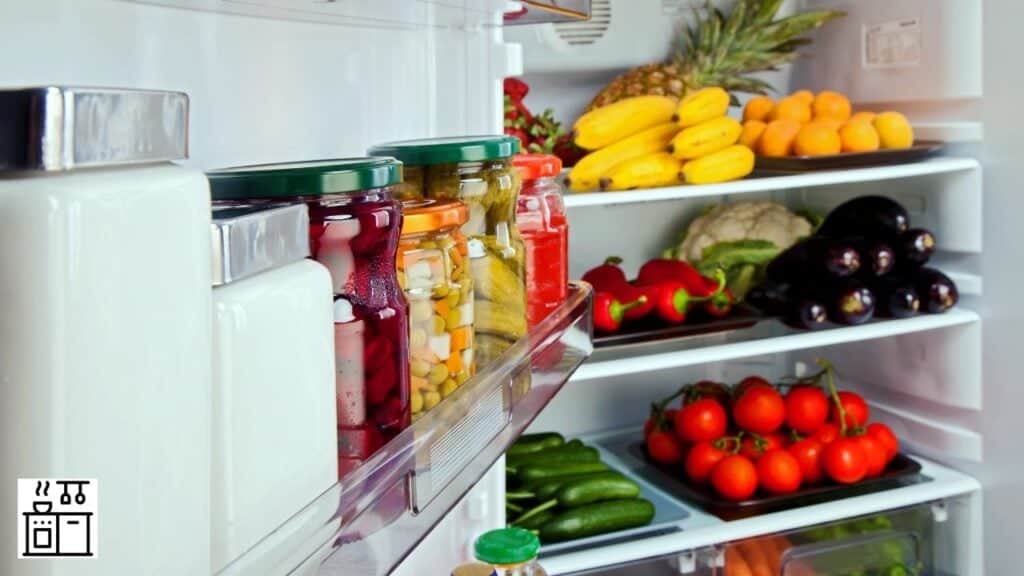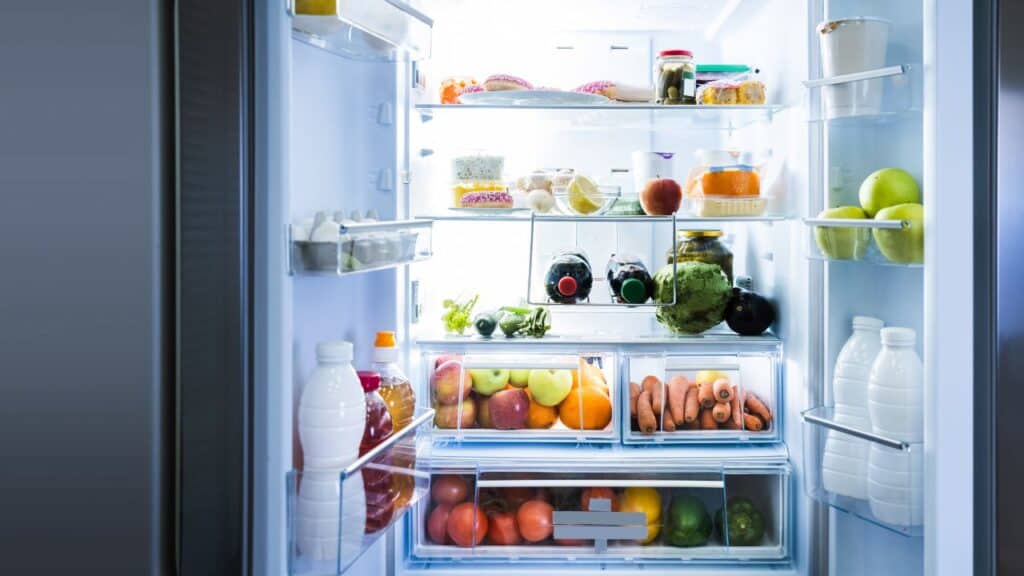A refrigerator is an electrical appliance with a thermally insulated compartment that keeps contents cool.
These devices have a refrigerant that flows through a sealed system, drawing heat out of the fridge. Thus, they preserve food by keeping them at a lower temperature at which microbes can’t grow.
Over time, the design and functionality of a refrigerator have evolved drastically. Nonetheless, the purpose remains the same.
Let’s try to understand how it works in closer detail.
Important Components of A Refrigerator
At the heart of a refrigerator is a compressor. It’s a pump that constricts the gaseous refrigerant and releases it into the condenser coils.
Now, the refrigerant is a fluid that changes from liquid to gas and vice-versa during the refrigeration process.
The main function of the refrigerant is to suck heat out of the fridge compartment and pump it to the outside. Hence, it’s a liquid that evaporates inside the refrigerator, creating cold temperatures.
An important characteristic of a refrigerant is that it changes from liquid to gas and back during the process.
Apart from the compressor and refrigerant, refrigerators have three components. The first is a condenser coil. These coils are located outside the refrigerator.
The refrigerant passes through these coils, sucking heat from the inner compartment.
Next, are evaporator coils located on the inside of the refrigerator. Finally, there is an expansion device.
Principle of Operation of A Refrigerator
When you rub alcohol on your skin and leave it on, it evaporates, leaving your skin feeling cold. This is similar to how refrigerators work.
When the refrigerant evaporates, it traps heat and produces a low ambient temperature. So, how does this happen? Let’s find out.
Refrigerators have long serpentine pipes running back and forth along the outside and inside compartments.
In older units, these pipes were filled with Freon gas. But Freon was linked to various environmental issues. Hence, it was replaced by other gases as refrigerants.
Now, the refrigerant inside these pipes begins in a liquid state. The compressor pumps it through the tubes, making it flow freely.
During this process, the refrigerant transforms into a gaseous form, sucking heat in. As warm air exits the fridge in this manner, the temperature of the refrigerator compartment falls.
The vaporized refrigerant then flows into the thinner pipes outside the fridge, releasing the heat it absorbed. During this process, it changes into a liquid again.
The entire process repeats continuously.
As a result, the temperature of the refrigerator compartment falls. When it reaches the desired temperature, the compressor shuts off. Over time, the temperature rises. This makes the compressor start working, repeating the process of refrigeration. This creates a characteristic kicking sound that we associate with the compressor activating.
Since refrigerators suck hot air out of the compartment and release it to the environment, the space behind and on the sides of a refrigerator is usually warm.
A Closer Look at The Different Components of A Refrigerator
Here are the various components of a refrigerator.
Compressor
The compressor is the heart of a refrigerator. It’s responsible for compressing the refrigerant gas and increasing its pressure during the cooling cycle.
The main function of this part is to compress the low-pressure refrigerant gas from the evaporator.
The compressor has an electric motor and a piston that moves up and down, causing a suction and compression cycle.
When the piston moves downward, it creates low pressure. This enables the refrigerant to enter the compressor.
When the piston moves upward, it compresses the gas, increasing its pressure and temperature. This process will expel the gas into the condenser coils.
Hence, the compressor plays an important part in maintaining the flow of the refrigerant through the system.
Depending on the model, there are four types of compressors used in refrigerators: reciprocating, rotary, scroll, centrifugal, and screw.
Household refrigerators typically have reciprocating compressors.
Condenser

A condenser removes heat from the compressed refrigerant and condenses it into a liquid.
The coils of a condenser are usually made of copper or aluminum. They provide a large area for heat exchange.
When the condenser cools the refrigerant, it undergoes a phase change from gas to liquid. This liquid then flows to the expansion valve for the rest of the process.
There are different types of condensers, like air-cooled condensers, water-cooled condensers, evaporative condensers, shell-and-coil condensers, and plate heat exchangers.
The choice between them will depend on factors like the size of the refrigeration system, cooling requirements, and installation conditions.
Expansion Valve
The expansion valve regulates the flow of liquid refrigerant at high pressure from the condenser to the evaporator.
It creates a pressure drop to control the amount of refrigerant entering the evaporator.
This pressure drop allows the refrigerant to evaporate rapidly and absorb heat, allowing the refrigerator to cool rapidly.
Evaporator
The main task of an evaporator is to facilitate the evaporation of the low-pressure liquid refrigerant.
When the liquid refrigerant enters the evaporator, it comes into a low-pressure environment created by the expansion valve.
This makes it evaporate and absorb heat from the surroundings. Like the condenser, the evaporator coils are also made of copper or aluminum to increase the area of heat exchange.
The design and functionality of an evaporator depend on various factors, like the size of the refrigerator, cooling requirements, and space availability.
Refrigerant
Refrigerants have unique properties that enable them to effectively undergo a phase change from low-pressure gas to high-pressure liquid and vice-versa.
This phase change creates the heating and cooling effect that drive the refrigeration process.
Some of the essential properties of a good refrigerant are a low boiling point, high latent heat of vaporization, good thermodynamic properties, stability, and low environmental impact.
Commonly used refrigerants include HFCs (hydrofluorocarbons), HCFCs (hydrochlorofluorocarbons), HCs (Hydrocarbons), Ammonia, and Carbon Dioxide.
Various factors like safety considerations, system requirements, and environmental impact decide the choice of refrigerant.
Modern Refrigerator Features
Over the years, refrigerators have evolved significantly.
Modern refrigerators have advanced technological and innovative features that make them more convenient and energy-efficient. They also have better storage capabilities.
A notable advancement in refrigerator technology is the emergence of smart refrigerators. These appliances have various intelligent features like internet connectivity for remote monitoring and control.
Higher energy efficiency is also an added advantage of many newer refrigerator models.
These refrigerators optimize power usage and reduce energy consumption through energy usage tracking and the use of energy-efficient components.
They also come with vacation mode settings, where you can adjust the cooling setting to reduce power usage.
Smart refrigerators will have flexible shelving and compartment customization to hold different items of various sizes. It also has specialized storage zones to cater to specific items.
Door-in-door design refrigerators usually feature an additional compartment that is accessible from the outer door.
It allows users to frequently access items without fully opening the main door, thus improving energy efficiency.
They also come with special compartments and shelves with temperature optimization capabilities to store special food and produce.
This helps users to store deli meats, beverages, and delicate produce at the optimum storage condition.
Thus, modern refrigerators are not just cooling appliances. They serve additional functions as well. They are advanced connected devices that offer convenience, energy efficiency, and enhanced storage.

